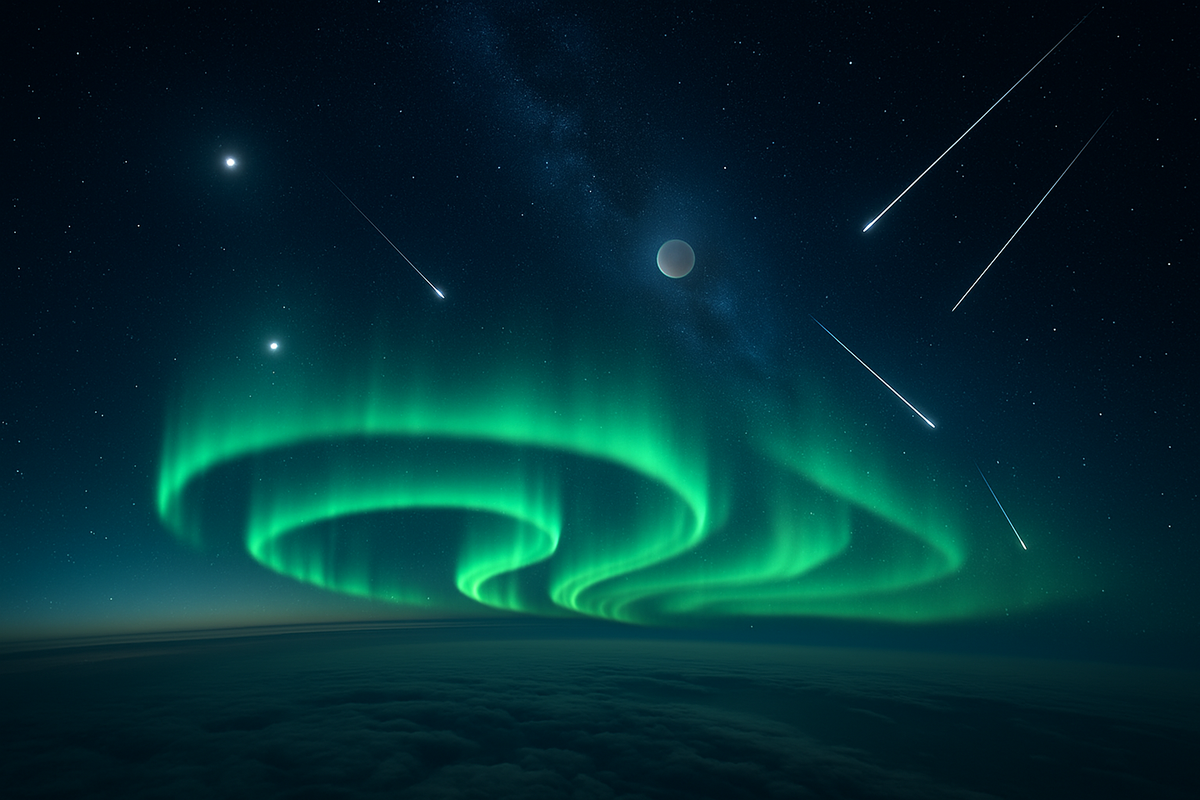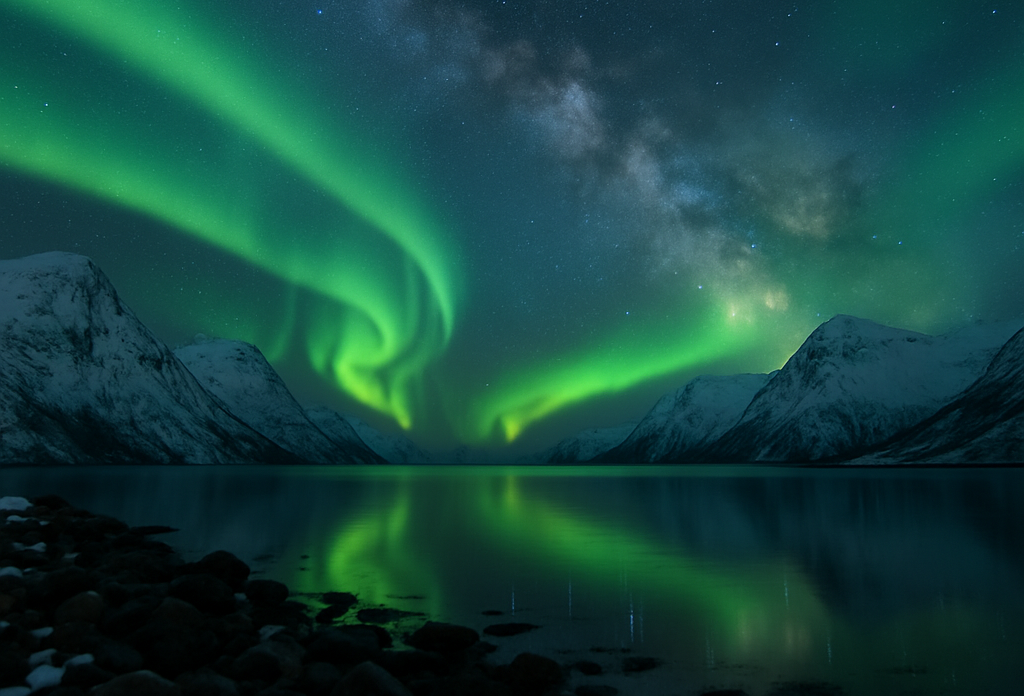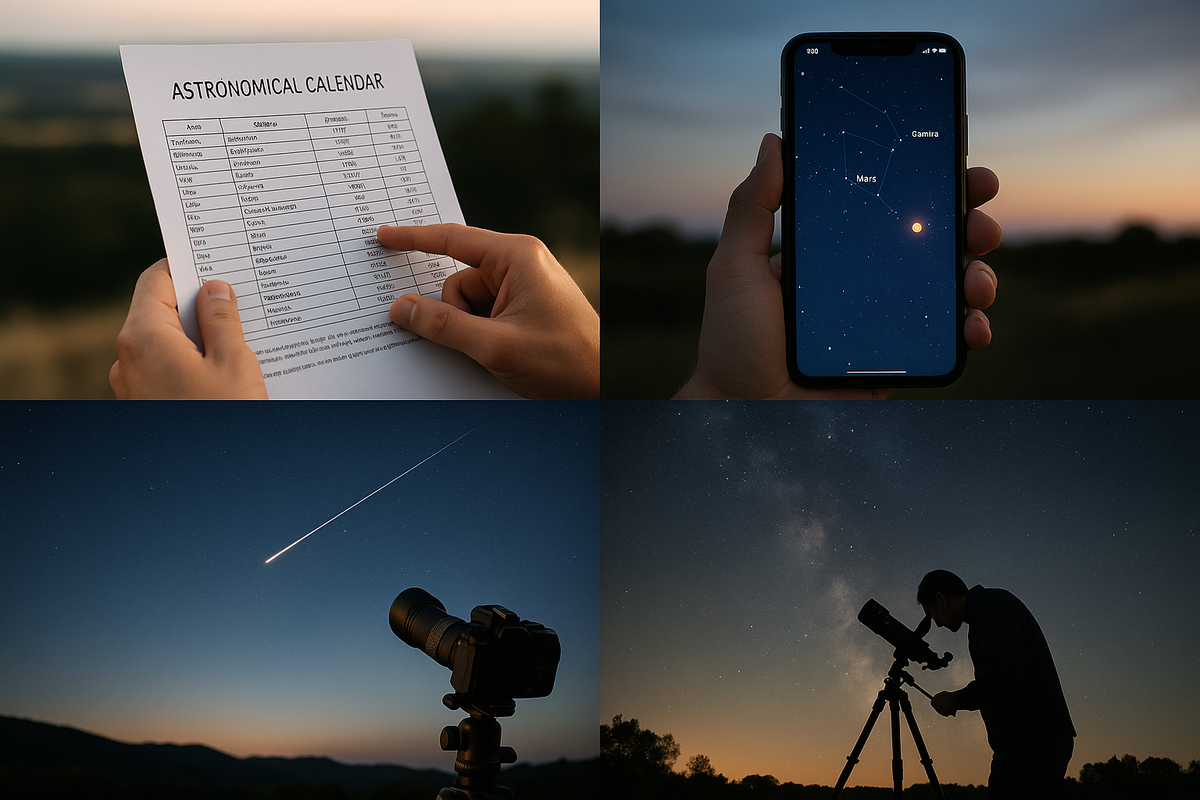🚀🌌 Experiments under the stars: how to combine the northern lights with other astronomical phenomena

The Northern Lights are an awe-inspiring sight in themselves. But what if you want to get even more out of the experience? Just imagine the sheer brilliance of the Aurora Borealis, mesmerising in its splendour, set against the majestic spectacle of meteor showers, the grand symphony of planetary conjunctions, and the ethereal beauty of astrophotography, all captured from the vantage point of a train or plane! In this article, we'll show you how to transform your regular aurora hunt into an unforgettable astronomical adventure.
🌠 Meteors and auroras: the best nights for a double show
The combination of meteor showers and the Northern Lights is a rare but possible event, which makes it an incredible sight to behold! I'm thrilled to tell you about this year's key meteor showers! They'll be coinciding with the aurora season, which is going to be an amazing sight to behold!
📈 Meteor Showers — Peak Windows & Visibility in Norway
| Meteor shower | Period | Peak activity | Visibility in Norway |
|---|---|---|---|
| Orionids fast | October | 21–22 | Excellent, with clear skies |
| Leonids | November | 17–18 | Excellent, moderate activity |
| Geminids bright | December | 13–14 | Perfect, bright stream |
| Quadrantids | January | 3–4 | Excellent, high intensity |
✈️🚆 "Sky on wheels": photographing the aurora from a train or plane
📸 Photography from an airplane: life hacks
● Sit by the window: book your seats in advance and choose the left side (when flying north).
● Camera settings: ISO 3200–6400, shutter speed 1 to 4 seconds, aperture f/2.8 or wide open.
● Tips: press the camera against the window for stability, block the cabin light with a jacket or blanket.
🚄 Photography from a train (Oslo–Tromsø or Bergen–Oslo route)
● Choose night trains and avoid seats near bright interior lighting.
● ISO 3200, shutter speed 5–10 seconds, use a mini tripod or rest the camera on the window.
● A wide-angle lens (14–24 mm) is suitable for capturing the panorama.
📌 Tip:
Check train schedules and routes on Vy.no and airline websites (SAS, Norwegian).
🪐✨ Planets and auroras: planetary conjunctions and visibility in Norway
During the northern lights season, you can observe bright planetary conjunctions and planetary alignments:
● Jupiter and Venus conjunctions: particularly bright and noticeable.
● Mars and Saturn: less bright, but add a special atmosphere to the images.
📅 Calendar of interesting conjunctions (2025–2026)
● Jupiter–Venus: 2 March 2025 (clearly visible at dawn)
● Saturn–Mars: 10 January 2026 (visible in the evening sky)
● Jupiter–Saturn: 31 October 2026 (evening observation)
📌 Tip:
Use apps such as SkyView Lite or Star Walk to find planets in the sky and easily navigate.
🌌 Can you see the Milky Way together with the aurora?

Yes, the Milky Way is clearly visible from northern Norway on clear, dark nights, especially during the new moon. Amazingly, it's actually possible to capture both the Northern Lights and the Milky Way in the same frame, creating stunning compositions that are simply out of this world!
✅ Tips for photographing the Milky Way with the aurora:
● ISO 3200–6400, exposure time 10–15 seconds, wide-angle lens (14–20 mm), aperture f/2.8.
● Use a tripod and pre-set the focus to infinity.
● Try to choose a time when there is no moon and minimal city lights.
Astrophotography and aurora: top tips for beginners
If you want to try your hand at astrophotography, remember the basic rules:
- Stability is key: use a sturdy tripod.
- Set the focus in advance: always manually, to infinity.
- Shoot in RAW format: to get the most detail in post-processing.
- Use interval shooting: to create time-lapses.
- Don't forget about composition: place objects in the foreground for scale and drama.
🎬 Time-lapse photography of the sky and stars: where to start?
Time-lapse photography is a great way to show how the sky and stars move:
- Set your camera to take photos at an interval. You can choose to take one photo every 5 to 15 seconds.
- You will need between 200 and 300 frames for a 10-second video.
- Use the following software to process: LRTimelapse, Adobe Lightroom or Adobe Premiere Pro.
🌙 The moon and the northern lights: friend or foe?
A full moon can sometimes make it hard to see faint auroras, but during moderate or high activity, it can make your photos look really nice.
● Pros: illuminates the landscape, helps to adjust focus.
● Cons: reduces the contrast of faint auroras.
📌 Tip:
Check the moon phases in advance and choose a time when the sky is either completely dark (new moon) or half-lit (first quarter).
🚩 Places for stargazing in Norway
The best locations for stargazing and photographing the starry sky:
● 📍 Senja and Lofoten Islands: minimal light pollution, stunning landscapes.
● 📍 Finnmarksvidda: flat plateau, complete darkness.
● 📍 Lyngen Alps: unique mountain panoramas, perfect foreground for photography.
🎯 Summary and key tips:
- Look at the astronomical calendar to see when meteors and planets are visible.
- Try using apps to find objects in the sky.
- Try different ways to film: from above, from the side, or slowly moving through time.
- To see the stars more clearly, make sure you plan your observations when there is a new moon.

💬 Share your experience!
Have you had the chance to combine the northern lights with other astronomical phenomena yet? Have you ever tried shooting from a plane or train? We can't wait to read your stories and tips in the comments!
We can't wait to feature the best recommendations and stories from readers in our next articles! 🌠 ✨





1 comment
Log in to leave a comment